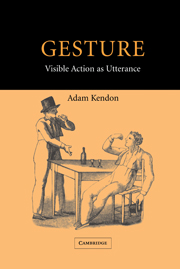Book contents
- Frontmatter
- Contents
- Acknowledgments
- 1 The domain of gesture
- 2 Visible action as gesture
- 3 Western interest in gesture from Classical Antiquity to the eighteenth century
- 4 Four contributions from the nineteenth century: Andrea de Jorio, Edward Tylor, Garrick Mallery and Wilhelm Wundt
- 5 Gesture studies in the twentieth century: recession and return
- 6 Classifying gestures
- 7 Gesture units, gesture phrases and speech
- 8 Deployments of gesture in the utterance
- 9 Gesture and speech in semantic interaction
- 10 Gesture and referential meaning
- 11 On pointing
- 12 Gestures of ‘precision grip’: topic, comment and question markers
- 13 Two gesture families of the open hand
- 14 Gesture without speech: the emergence of kinesic codes
- 15 ‘Gesture’ and ‘sign’ on common ground
- 16 Gesture, culture and the communication economy
- 17 The status of gesture
- Appendix I Transcription conventions
- Appendix II The recordings
- References
- Index
9 - Gesture and speech in semantic interaction
Published online by Cambridge University Press: 05 February 2015
- Frontmatter
- Contents
- Acknowledgments
- 1 The domain of gesture
- 2 Visible action as gesture
- 3 Western interest in gesture from Classical Antiquity to the eighteenth century
- 4 Four contributions from the nineteenth century: Andrea de Jorio, Edward Tylor, Garrick Mallery and Wilhelm Wundt
- 5 Gesture studies in the twentieth century: recession and return
- 6 Classifying gestures
- 7 Gesture units, gesture phrases and speech
- 8 Deployments of gesture in the utterance
- 9 Gesture and speech in semantic interaction
- 10 Gesture and referential meaning
- 11 On pointing
- 12 Gestures of ‘precision grip’: topic, comment and question markers
- 13 Two gesture families of the open hand
- 14 Gesture without speech: the emergence of kinesic codes
- 15 ‘Gesture’ and ‘sign’ on common ground
- 16 Gesture, culture and the communication economy
- 17 The status of gesture
- Appendix I Transcription conventions
- Appendix II The recordings
- References
- Index
Summary
Utterances, we have suggested, are like objects that are constructed out of spoken and gestured materials and, accordingly, may be said to have two components. In the preceding two chapters, we showed, through a series of examples, some of the different ways in which these may be put together. With this chapter we begin a consideration of how the gestured component contributes to the meaning or expression of the utterance.
The gestured component of an utterance can be a part of its referential content. For example, when JJ, in Example 11, moves his hand forward as if he were leafing through a book of cloth samples as he says “what with going through reams of curtain material books” his gesture makes reference to actions involved in looking through the curtain material books, which is part of the content of his utterance. Likewise, the ‘throwing away’, ‘knocking down’ and ‘placing’ gesture phrases in Example 3, or the gesture in Example 4 that was associated with R saying ‘they made everything greasy’, the so-called ‘outlining’ movement of SM in Example 2 as she refers to “wonderful window displays” or M's raised two-finger action in Example 14 which gives prominence to the idea that there are ‘two things’ typically referred to when one speaks about Naples, are all instances of gestures that are a part of the referential content of their respective utterances.
- Type
- Chapter
- Information
- GestureVisible Action as Utterance, pp. 158 - 175Publisher: Cambridge University PressPrint publication year: 2004
- 1
- Cited by

